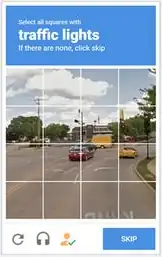In the vast expanse of the internet, distinguishing between human users and automated bots is a critical challenge for website administrators. CAPTCHA, which stands for Completely Automated Public Turing test to tell Computers and Humans Apart, serves as a robust solution to this problem. This technology is designed to prevent automated software from performing actions that could potentially harm websites, ensuring that only humans can access certain functionalities.
As we delve deeper, we’ll explore the inception of CAPTCHA, its importance in the digital world, why it’s widely implemented across the web, and how it stands up against emerging alternatives.
Index:
- The Birth of CAPTCHA
- Why CAPTCHAs Are Everywhere
- Alternatives to CAPTCHA
- Is CAPTCHA Still the Best Option?
- Invisible CAPTCHAs
- References

1. The Birth of CAPTCHA
CAPTCHA was developed out of necessity in the burgeoning era of the internet. As the online space expanded, so did the activities of malicious bots capable of spamming sign-up forms, manipulating polls, and performing brute-force attacks. The academic community realized the need for an automated method to prevent non-human actors from abusing web services, leading to significant research and development efforts.
The term “CAPTCHA,” which stands for Completely Automated Public Turing test to tell Computers and Humans Apart, encapsulates its purpose. It is a clever play on the word “capture,” while also paying homage to Alan Turing, who proposed the Turing Test as a measure of machine intelligence in 1950. Turing’s concept involved a human evaluator who would judge natural language conversations between a human and a machine designed to generate human-like responses. If the evaluator could not reliably tell the machine from the human, the machine could be considered to have passed the test. Similarly, a CAPTCHA challenges users to prove they are not machines by solving tasks that are easy for humans but difficult for automated systems.
The team that coined the term “CAPTCHA” in 2000 included Luis von Ahn, Manuel Blum, Nicholas Hopper, and John Langford from Carnegie Mellon University. Their invention was not just a mere test but a groundbreaking approach to secure automated systems using challenges that are straightforward for humans yet complicated for bots to decipher.
2. Why CAPTCHAs Are Everywhere
The rapid adoption and widespread use of CAPTCHAs across the internet can be attributed to their effectiveness in preventing a myriad of automated threats. Simple, traditional tasks such as deciphering distorted text or identifying a series of images allow websites to easily differentiate between human users and automated agents. This method provides a first line of defense against various forms of misuse and abuse, such as automated account creation, spamming, and other malicious activities.

Additionally, the implementation of CAPTCHAs is straightforward and cost-effective, making them accessible to websites of all sizes. Small businesses and large enterprises alike can deploy CAPTCHA systems using readily available plugins and services, integrating them into their existing infrastructures without substantial overhead or specialized knowledge.
The ubiquity of CAPTCHAs is also bolstered by their adaptability. As bots become more advanced, CAPTCHA technology evolves to present more complex challenges that are still within the capabilities of most users. For instance, the transition from text-based CAPTCHAs to image recognition tasks and interactive puzzles has helped maintain their efficacy in the face of increasingly sophisticated automated threats.
By serving as a gatekeeper that ensures only human users can proceed, CAPTCHAs play a critical role in maintaining the integrity and security of online operations. This security measure helps preserve user trust and confidence in digital platforms, contributing to a safer and more reliable Internet ecosystem. As technology advances, the CAPTCHA system continues to adapt, ensuring it remains an essential component of online security strategies.
3. Alternatives to CAPTCHA
Despite its popularity, CAPTCHA is not without its drawbacks. Challenges like image recognition or puzzle-solving can be frustrating for users, leading to poor user experience. Moreover, sophisticated bots have begun to outsmart some types of CAPTCHAs, prompting the development of alternative methods.
Alternatives include biometric verification, such as fingerprint or facial recognition, and behavioral analysis, which monitors how users interact with a website to identify human-like patterns. Another innovative approach is the use of honeypots—hidden fields on forms that are invisible to human users but are often filled out by bots, thereby identifying them for exclusion.
4. Is CAPTCHA Still the Best Option?
While CAPTCHA remains a go-to solution for many websites, its effectiveness and user experience are increasingly being questioned. Alternatives that offer seamless user interactions without compromising security are gaining traction. Yet, for many small to medium-sized websites, CAPTCHA provides a balance of cost, ease of implementation, and protection.
See also: Understanding RADIUS.
5. Invisible CAPTCHAs
Modern CAPTCHAs, often referred to as “invisible CAPTCHAs,” use a more sophisticated approach to differentiate between humans and bots without interrupting the user experience with active challenges like image selection or text input. The most well-known example of this technology is Google’s reCAPTCHA v3. Here’s a technical breakdown of how these systems work:
5.1 Risk Analysis Engine
The core of modern CAPTCHA technology is a risk analysis engine that operates in the background as the user interacts with a website. Instead of presenting a challenge, the system analyzes various aspects of the user’s interaction with the website in real-time.

5.2 User Interaction Metrics
Modern CAPTCHAs monitor several indicators that may differentiate a human from a bot. These include:
- Mouse Movements: How the mouse is moved across the screen can be very telling. Human movements tend to be less predictable and more curved than those of automated scripts.
- Keystroke Dynamics: The timing and rhythm with which keys are pressed can help identify human users. Humans usually have more variation in typing speed.
- Scrolling Behavior: How and when a user scrolls through content is also evaluated. Humans scroll in a more irregular and less linear fashion than bots.
5.3 Device and Browser Fingerprinting
The technology also leverages device fingerprinting, which gathers information about the user’s device, browser type, language settings, and even installed fonts. Bots often have different profiles compared to typical user devices.
5.4 Cookies and Browser History
Modern CAPTCHAs may check for cookies placed by other sites or the CAPTCHA service itself to recognize returning users. A regular user would likely have a history of interactions that a bot would not simulate accurately.
5.5 Machine Learning Algorithms
All collected data points are processed using advanced machine learning algorithms that can detect anomalies indicative of bot activity. These algorithms learn from vast datasets to improve their accuracy over time, adapting to new bot tactics as they develop.
5.6 Score-Based System
Rather than giving a simple pass or fail result, modern CAPTCHAs typically generate a score indicating the likelihood that the user is human. Website administrators can set thresholds for these scores, deciding when to step up security or simplify user access.
Conclusion
This invisible verification process enables websites to maintain high security without harming the user experience, providing a seamless interaction for most users. Only those flagged as potential bots might be prompted to verify their identity through more traditional CAPTCHA tasks, ensuring both security and accessibility. This adaptive approach is what sets modern CAPTCHAs apart and illustrates their technical sophistication.
6. References
- “The CAPTCHA: Perspectives and Challenges“ by Darko Brodić, Alessia Amelio, 2019.
- “Artificial Intelligence: A Guide for Thinking Humans“ by Melanie Mitchell, 2019. While not exclusively about CAPTCHAs, this book provides insight into AI challenges and solutions, which are central to understanding how CAPTCHAs work.
- RFC 4732 – Internet Denial-of-Service Considerations: Although not directly about CAPTCHAs, this RFC discusses broader security mechanisms which include discussions relevant to understanding why CAPTCHAs are a necessary part of securing Internet applications against abuse.
- “Computer Networking: Principles, Protocols, and Practice“ by Olivier Bonaventure. This textbook, available under a Creative Commons license, explains the underlying network principles that are also pertinent to the deployment of CAPTCHAs.